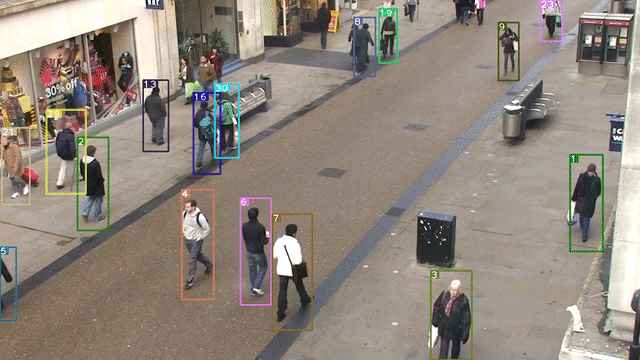Understanding DeepSORT: A Deep Dive into Real-Time Multi-Object Tracking
For computer vision, tracking multiple objects over video frames is an underlying problem. Autonomous vehicles to surveillance systems, following the movement of individuals or objects accurately is essential. DeepSORT fits the bill—a robust advancement over the SORT (Simple Online and Realtime Tracking) algorithm for strengthening robustness and accuracy in real-time multi-object tracking.
What is DeepSORT?
In essence, DeepSORT enhances SORT by overcoming its greatest weakness: sensitivity to crowded or occluded environments. While SORT uses a simple Kalman Filter for motion prediction and Hungarian algorithm for frame-to-frame matching, it falters whenever objects occlude or have unpredictable trajectories. DeepSORT addresses this through the use of deep learning for appearance-based matching.
What is Multi-Object Tracking?
Multi-object tracking (MOT) refers to the process of locating and following multiple objects in a video or image sequence over time. To achieve this, multi-object tracking algorithms typically use a combination of object detection, data association, and trajectory prediction techniques.
How it Works
DeepSORT presents a deep neural network that derives appearance features for every detected object. These are used to build embeddings. When processing a new frame, the algorithm does not depend on spatial data. It takes these embeddings and compares them with tracked objects to obtain a best match even when motion-based predictions break down.
By combining motion (through Kalman Filter) and appearance features (through deep features), DeepSORT significantly minimizes identity switches—where the tracker incorrectly exchanges IDs of two objects. This is why it proves to be especially helpful in crowded surroundings such as shopping malls, train stations, or pedestrian-dense cityscapes.
Core Components
Detection Phase: DeepSORT begins with an external object detector (such as YOLO etc.) detecting objects within every frame. Every detection comes along with a bounding box and confidence score.
Motion Prediction: Each object’s next position is predicted using its velocity and path through a Kalman filter. In this step, the place of current tracks is predicted where they ought to turn up in the next frame.
Appearance Descriptor: Each recognized object has a special “appearance signature” created by a deep neural network. This appearance vector holds visual features (e.g., color, texture) so that objects can be identified even if motion prediction fails.
Data Association: Hungarian algorithm associates detections with tracks based on a composite cost measure:
Mahalanobis distance: Quantifies consistency between predicted and actual detection motion.
Cosine distance: Compares appearance features to guarantee visual appearance similarity.
Tracks and detections are associated only if both measures are below adaptive thresholds.
Track Management: Tracks are validated following successive detections to prevent false alarms. Tracks beyond a “max age” value (i.e., 5 frames not detected) are cancelled, and fresh tracks are created by new detections.
Advantages of DeepSORT
- Enhanced Identity Tracking
DeepSORT greatly minimizes ID switches due to applying deep appearance features, which ensure consistent identities even for crowded or occluded scenes. - Real-Time Performance
Although it uses a deep neural network, DeepSORT is optimized for real-time applications and can be used with live video streams and time-critical applications. - Strong in Occlusions and Overlaps
SORT and other traditional trackers have poor performance when objects overlap. DeepSORT, using both motion and appearance cues, performs better in these cases. - Easy Integration with Object Detectors
DeepSORT is detector-agnostic. It can be used with any object detection model (YOLO, Faster R-CNN, etc.), making it more flexible to various applications. - Open-Source and Actively Used
DeepSORT being open-source has a large supporting community and is actively used in research and industry projects, and one can easily find help and enhancements.
Disadvantages of DeepSORT
- Dependency on Detection Quality
Similar to most tracking-by-detection methods, DeepSORT is largely dependent on the object detector’s performance. A bad detector results in bad tracking. - Computational Overhead
Having a deep neural network for appearance embedding adds computational overhead compared to less complex trackers like SORT. - Not End-to-End
DeepSORT is not an end-to-end tracker. There is a need for an independent detector and pre-trained feature extractor, making the pipeline setup more complicated. - Limited Handling of Long-Term Occlusions
Though improved over SORT, DeepSORT itself still has issues with extremely long occlusions or re-detection of objects after leaving and then re-entering the frame. - Requires Feature Extraction Model Training
If custom data or domains (e.g., other object classes) are to be used, the appearance model will need to be retrained to perform best.
Applications in the Real World
DeepSORT has found applications in many fields :
- In surveillance, it is used to track individual movements in public places.
- It’s applied in retail to study customer behavior.
- Sports analytics platforms utilize it in order to track players on the field in real-time.
- Even in autonomous driving systems, object tracking plays an important role in comprehending the dynamic world.

Fig : Output illustrating how DeepSORT assigns ids to detected persons/objects.
Conclusion
DeepSORT’s incorporation of deep learning into the conventional tracking paradigm is a bright and clever answer to one of computer vision’s most challenging issues. It’s as fast as it is accurate, hence why it’s widely used for real-time tasks. With advancement in hardware and models, we can anticipate even more sophisticated variants of DeepSORT to surface—taking us closer to the realization of genuinely intelligent visual systems.


